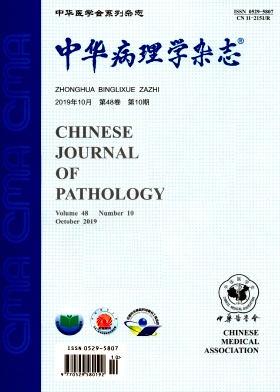支气管腺瘤88例临床及分子特征分析
摘要
目的:探讨支气管腺瘤(BA)的临床病理特征、基因突变及分布。方法:收集2015年5月~ 2024年2月在中国上海复旦大学附属中山医院病理科(71例)和济宁市第一人民医院病理科(17例)经常规切片诊断的BA病例88例。临床资料,图像特征,组织病理切片,免疫组织化学染色和基因检测结果进行了回顾。结果:88例BA患者中,男性36例,女性52例。近端型BA在两性中的发病率相同(50%,28/56),而远端型BA在女性中更为常见(75%,24/32,P=0.022)。BA主要影响中老年人,年龄范围为30-78岁(中位数为61岁)。临床上BA一般无明显症状。影像学上主要表现为肺周围性磨玻璃结节、混合性磨玻璃结节或实性结节,主要位于肺下叶(72.7%,64/88)。近端型BA以实性结节为主(53.6%,30/56),远端型BA以磨玻璃结节为主(56.3%,18/32),差异有统计学意义(P0.01)。肿瘤未包被,切面灰白色,部分区域灰褐色。在18.2%(16/88)的病例中,切口表面光滑,软到中等硬度,边缘不清晰。近端型BA(14/16)质地光滑,肿瘤直径0.2 ~ 4.6 cm。镜下病变呈腺状、乳头状或相对扁平状,主要细胞成分由基底细胞、纤毛柱状细胞、粘液细胞和不同比例的肺泡上皮细胞组成。近端型BA与近端细支气管形态相似,通常含有黏液细胞和纤毛细胞,而远端型BA通常缺乏黏液细胞和纤毛细胞。近端型BA纤毛细胞微乳头出现频率为64.3%(36/56),远端型BA为31.3% (10/32,P=0.003)。近端型BA的腺管扩张形态学表现(98.2%,55/56)高于远端型BA (81.25%, 26/32, P=0.009)。总体而言,冷冻切片与常规诊断的不符合率为19.5%(17/87)。细胞角蛋白5/6 (CK5/6)和p40的免疫组化检测显示,近端型BA的基底细胞连续性(82.1%,46/56)显著高于远端型BA (56.2%, 18/32, P=0.009)。分子检测显示,BA基因累积突变率为60.5%(23/38),其中BRAF V600E突变34.2% (13/38),KRAS突变18.4% (7/38),ALK突变5.3% (2/38),EGFR突变2.6%(1/38)。近端型BA与BRAF V600E突变相关,远端型BA与KRAS突变相关(P=0.025)。结论:BA是一种罕见的支气管良性肿瘤,术中冰冻切片诊断错误率高。近端型BA常表现为纤毛细胞微乳头状突起,支持诊断,而远端型BA常表现为基底细胞部分减少或缺失,增加了诊断难度。BA的不同亚型表现出不同的基因(突变)谱,这可能有助于其诊断和组织学分类。Objective: To investigate the clinicopathological features, gene mutations, and distribution of bronchial adenoma (BA). Methods: Eighty-eight cases of BA diagnosed via routine section diagnosis between May 2015 and February 2024 were collected at the Pathology Departments of Zhongshan Hospital Affiliated to Fudan University (71 cases), Shanghai, China and Jining No.1 People's Hospital (17 cases), Jining, China. Clinical data, image features, histopathological sections, immunohistochemical stains, and genetic testing results were reviewed. Results: Among the 88 patients with BA, there were 36 males and 52 females. The incidence of proximal-type BA was the same in both genders (50%, 28/56), while distal-type BA was more commonly found in females (75%, 24/32, P=0.022). BA predominantly affected middle-aged and elderly adults, with an age range of 30-78 years (median, 61 years). Clinically, BA generally presented without obvious symptoms. Radiologically it mainly manifested as peripheral lung ground-glass nodules, mixed ground-glass nodules, or solid nodules, primarily located in the lower lobes of the lungs (72.7%, 64/88). Proximal-type BA was characterized by solid nodules (53.6%, 30/56), while distal-type BA by ground-glass nodules (56.3%, 18/32), with a statistically significant difference between the two types (P<0.01). The tumor was non-encapsulated, with a gray-white cut surface, and some areas were gray-brown. In 18.2% (16/88) of cases, the cut surface was slippery, with soft to medium-firm consistency and poorly defined margins. The smooth texture was predominantly found in proximal-type BA (14/16), whose tumor diameters ranged from 0.2 to 4.6 cm. Microscopically, the lesions exhibited glandular, papillary, or relatively flat patterns, with the main cellular components consisting of basal cells, ciliated columnar cells, mucinous cells, and alveolar epithelial cells in various proportions. Proximal-type BA resembled the morphology of proximal bronchioles and commonly contained mucinous and ciliated cells, while distal-type BA typically lacked mucinous and ciliated cells. The frequency of ciliated cell micropapillae in proximal-type BA (64.3%, 36/56) was significantly higher than that in distal-type BA (31.3%, 10/32, P=0.003). The morphological manifestation of glandular duct dilation was more commonly noted in proximal-type BA (98.2%, 55/56) than that in distal-type BA (81.25%, 26/32, P=0.009). Overall, the disagreement rate between frozen-section and routine diagnoses was 19.5% (17/87). Immunohistochemistry for cytokeratin 5/6 (CK5/6) and p40 showed that basal cell continuity in proximal-type BA (82.1%, 46/56) was significantly higher than that in distal-type BA (56.2%, 18/32, P=0.009). Molecular testing showed an accumulative gene mutation rate of 60.5% (23/38) in BA, including mutations in BRAF V600E (34.2%, 13/38), KRAS (18.4%, 7/38), ALK (5.3%, 2/38), and EGFR (2.6%, 1/38). Proximal-type BA was associated with BRAF V600E mutations, while distal-type BA with KRAS mutations (P=0.025). Conclusions: BA is a rare benign bronchial tumor and has a high diagnostic error-rate on intraoperative frozen section. Proximal-type BA often presents with ciliated cell micropapillae, which supports the diagnosis, while distal-type BA frequently shows a partial reduction or absence of basal cells, increasing the diagnostic difficulty. The different subtypes of BA exhibit distinct genetic (mutation) profiles that may assist in its diagnosis and histological classification.

 求助内容:
求助内容: 应助结果提醒方式:
应助结果提醒方式:


